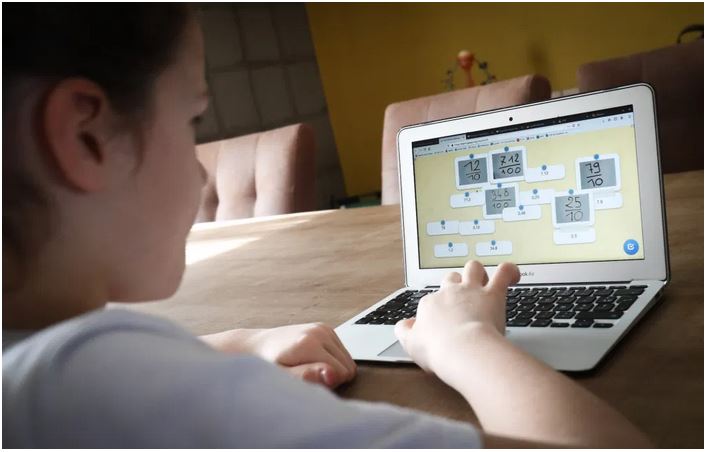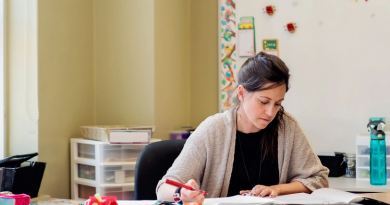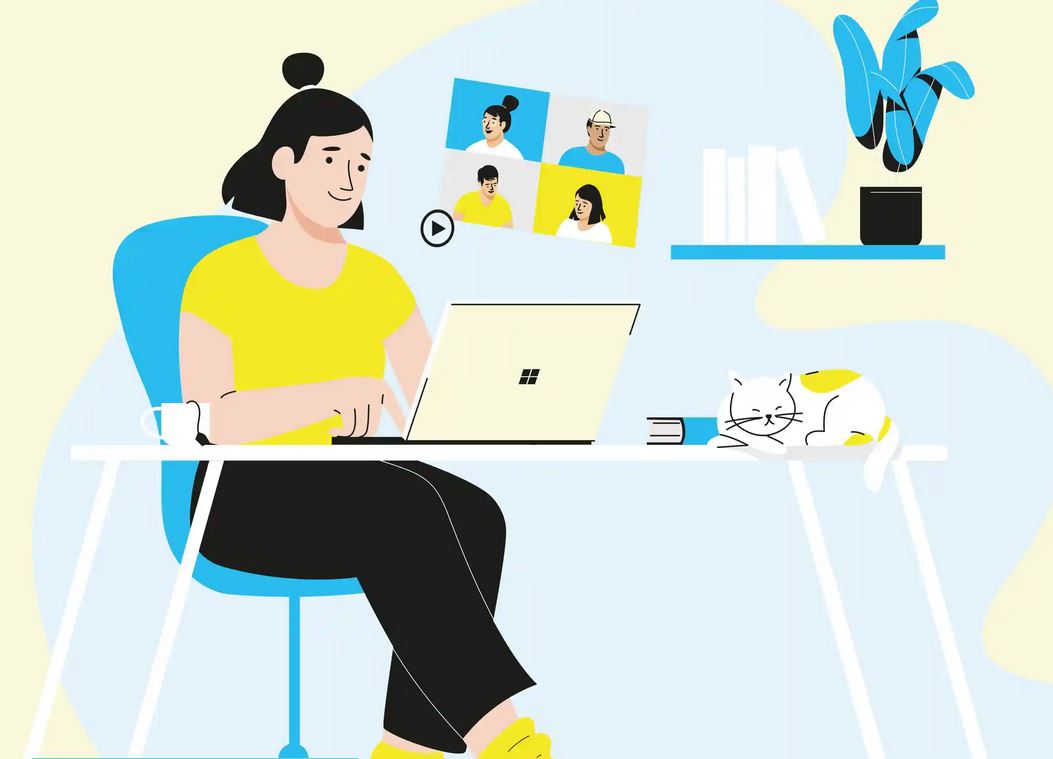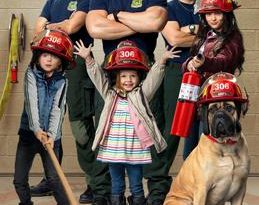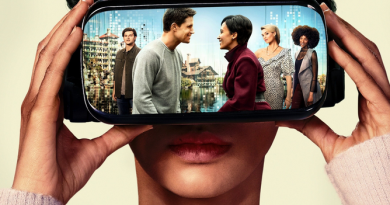Remote learning has been a disaster for many students. But some kids have thrived
John was having some trouble in class.
The seventh grader had been diagnosed with ADHD and a language disorder that makes processing verbal and nonverbal cues a challenge. Despite extra support he received through his Individualized Education Plan for students with disabilities, John often felt overwhelmed by the chaos of his middle school classroom.
“He just gets distracted,” said his mother, Alex, who spoke on the condition that her last name be withheld to protect her son’s privacy. “That’s his biggest issue.”
Dalton McKittrick is among a small number of students who have thrived in remote learning. Credit: Lanya McKittrick
And then, suddenly, John was no longer in class. Like millions of other American school children, he was pushed into remote learning from home when the coronavirus hit this spring.
But something surprising happened. John did better learning remotely than he had in person, the opposite of the experience of most students. He even received a certificate from his school, in a suburb of Boston, for excellence in remote learning, something given to only a handful of students.
“He misses friends, obviously, but at the same time, I can tell that there was a huge change in his stress levels, and he was able to concentrate on his schoolwork,” said Alex. “He enjoyed learning again. Before, school was kind of tedious for him.”
Remote learning has been a struggle for teachers and is expected to set back the learning gains of a generation of students. It has been particularly hard on children of color, kids from families who are financially insecure, and those without access to computers and technology at home.
But a small number of students have done unexpectedly well. In some cases, those students struggled with distractions in the classroom during in-person learning. In others, they had social challenges at school: They were anxious, easily drawn into conflicts with other students, or embarrassed to engage in front of their peers.
“The challenge of in-classroom [learning] can be the social interaction. And for some kids, that’s actually really hard,” said Lynette Guastaferro, chief executive officer of Teaching Matters, a nonprofit that focuses on increasing teacher effectiveness. She has noticed that the kids who preferred remote learning and were successful at it appreciated the independence of the online work and benefited from teachers who gave them clear direction in the virtual format.
“He enjoyed learning again. Before, school was kind of tedious for him.”
Alex, mother of a middle schooler
Some educators are now wondering how the experiences of kids who have done better during remote learning can be applied to improve in-person learning in the future. Takeaways might include having more social and emotional check-ins with students, increased inclusion of students with disabilities in general education class activities, wider use of technology, and accommodating unconventional techniques that individual students have found helpful.
“I know it’s a pandemic. I know it’s hellacious out there, I know it’s hard. I’m not saying it’s not all those things,” said Lauren Katzman, the executive director of the Urban Collaborative, a national network of more than 100 school districts focused on improving outcomes for students with disabilities. “I am saying there are opportunities that we’re not thinking about clearly, and I want us to.”
For John, the freedom to work at his own pace and manage his own time, along with a few incentives, played key roles in his success. When Alex allowed him to play video games on weekdays (not allowed before the pandemic) he started to get more involved in planning his schoolwork for the week, and frontloaded assignments so that he could take off Fridays, and sometimes even part of the day on Thursdays.
“He just kind of did that on his own, and saw the value of not procrastinating, like he normally would,” said Alex.
Listening to music while he did his schoolwork was also important.
“He often said, ‘I wish I could do this in school, I bet I could do so much better, and I could concentrate better,’ ” said Alex.
Allowing students like John to listen to music in a classroom is a simple accommodation a school could make in order for a student to learn better, according to Katzman. “It doesn’t cost anybody any money,” she said. “You don’t need any expertise in how to manage that. It’s a simple thing.”
She and other experts say some special education students, in particular, could benefit from schools taking lessons from distance learning back into the classroom.
For years, special education advocates have pushed to integrate more students with disabilities into general learning classrooms. Not all school districts have embraced this objective. But with remote learning, some schools have made an effort to hold general education activities that include kids with disabilities in order to build a sense of community, Katzman said. For example, a student with a disability might be included in a Zoom morning circle with general education kids, when in the past they would have spent that time in a special ed class with a smaller group.
“I know it’s a pandemic. I know it’s hellacious out there, I know it’s hard. I’m not saying it’s not all those things. I am saying there are opportunities that we’re not thinking about clearly, and I want us to.”
Lauren Katzman, executive director of the Urban Collaborative
“In some of my conversations with some district leaders across the country, they feel like it’s gotten better for some kids because there’s more inclusive practices, and they don’t want to go back,” said Katzman.
Technologies that became widespread during remote learning could benefit all kids once schools reopen for in-person instruction. Learning management systems, such as Google Classroom, which present educational materials in an organized way online, could become part of a new method of instruction that combines digital and traditional approaches for all students, Guastaferro said.
For kids with disabilities, that tech might include speech-to-text software or audio books. And when teachers record a video of a lesson, students who didn’t understand it the first time can watch it again.
“One-to-one technology is more of a norm than it’s ever been,” said Katzman. “We’ve been trying for that for a long time, and now it’s there.”
For some kids, online learning has also removed the social barriers that kept them from excelling.
Michael Allara, who teaches physics and chemistry at Fern Creek High School in Louisville, Kentucky, has seen this aspect of remote learning in action. Last school year, one of his students hesitated to ask questions in class; Allara surmised she was afraid of looking foolish in front of her peers. She was struggling so much with the material that she was at risk of failing the course, a requisite for graduation.
That changed during remote learning. When she could interact with Allara remotely, the student became much more engaged. She emailed and texted him with questions, and they spoke on the phone. She passed the class, and graduated high school in May.
“These students online were much more willing to speak their voice,” said Allara. “All of the sudden you feel comfortable advocating for yourself … That’s huge.”
“These students online were much more willing to speak their voice. All of the sudden you feel comfortable advocating for yourself … That’s huge.”
Michael Allara, teacher, Fern Creek High School in Louisville, Kentucky
Sarah Ott, the executive director of special education for the San Diego Unified School District, has noticed a similar trend among students who were very shy or anxious during in-person learning.
Online, these kids were able to ask questions of their teachers privately, or enter digital “breakout rooms” with staff, in which they could get one-on-one instruction apart from other students.
“Kids with anxiety, some of them didn’t come to school, and then they just didn’t learn,” said Ott, who now envisions a future with more options for those students.
Dalton McKittrick, 12, has benefited from some of the technology of remote learning.
He has low vision and is currently learning braille. He also uses bilateral cochlear implants to hear and struggles to separate speech from the background noise of a busy classroom. Like John, he has an Individualized Education Plan, or IEP.
Dalton said that it’s been helpful to see his teachers directly in front of him on a computer screen during remote learning, instead of across the room during in-person learning. On Google Meets in the spring, he attended digital breakout rooms with other students, separate from the “main room,” which could be noisy. Additional breaks throughout the day, which allow him to step away from his computer for a few minutes, have also been welcome.
“It kind of felt good just having your teachers care for you more, because they don’t want you to get sick, and they want you to get good grades and all that.”
Dalton McKittrick, 12
This fall, his school increased live instruction online; his mother, Lanya McKittrick, has advocated that Dalton receive more “listening breaks” to help prevent fatigue. During these periods, he turns off his camera and enters a quiet virtual breakout room to work by himself. Later, he can watch the lessons, which are recorded.
He said teachers at school have scheduled social check-ins with him more often than they did during in-person learning, and seem more invested in his emotional wellbeing.
“It kind of felt good just having your teachers care for you more, because they don’t want you to get sick, and they want you to get good grades and all that,” said Dalton.
Dalton is also getting a lot of one-on-one support from his mother, a research analyst with the Center on Reinventing Public Education, who specializes in special education and families.
He credits his success this spring to “having an amazing IEP team, having my mom with me helping me and just having a teacher check in, for the most part, making me inspired to do this more,” he said.
Guastaferro, of Teaching Matters, has seen how important small group check-ins with students can be. One teacher she works with started a “mood meter” with her third-grade students during remote learning. Kids could identify how they were feeling by picking from an array of faces that ranged in expression from excited and happy to neutral or sad and discuss their choice with their teacher. Having conversations about how students were feeling allowed the teacher to connect with them on a deeper level, and prompted those students to be more engaged during lessons.
For many educators, the forced pivot to remote learning has resulted in considering new ways districts can more closely tailor education to meet individual students’ needs once the pandemic is over.
“What we learned from being online is that we, as the public school system, could also offer flexible options,” said Ott of the San Diego school district. “Kids don’t have to be in a seat to learn … we can offer different options for kids, and not just go back to this one track that we were in.”
Source: https://hechingerreport.org/remote-learning-has-been-a-disaster-for-many-students-but-some-kids-have-thrived/

